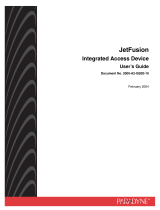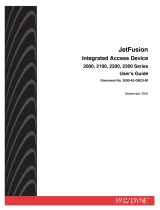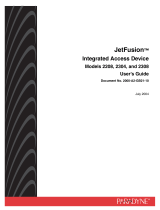
ENGLISH
Quick Installation Guide
INSYS SDSL
www.insys-icom.com
These short operating instructions apply for the following devices of INSYS icom:
INSYS SDSL 1.0
www.insys-icom.com/manual
It is intended for a quick commissioning by the operator. Refer to the associated manual for further information.
This and other associated manuals can be found on our website in the menu Support and Downloads >
Documentation. Scan the QR code above or enter the URL into your web browser.
Defects liability terms
A use other than the intended use, an ignorance of the safety instructions and the documentation, the use of insufficiently qualified
personnel as well as unauthorised modifications exclude the liability of the manufacturer for damages resulting from this. The liability of the
manufacturer ceases to exist.
Intended Use
The product may only be used for the purposes specified in the function overview of the manual. In addition, it may be used for the
following purposes:
Usage and mounting in an industrial cabinet.
Switching and data transmission functions in machines according to the machine directive 2006/42/EC.
Usage as data transmission device, e.g. for a PLC.
The product may not be used for the following purposes and used or operated under the following conditions:
Use, control, switching and data transmission in machines or systems in explosive atmospheres.
Controlling, switching and data transmission of machines, which may involve risks to life and limb due to their functions or when a
breakdown occurs.
Technical Boundaries
Max. line length for power supplies, inputs and outputs as well as other signals: 30 m
Max. line length of serial connection lines: 3 m
Cable cross-section: 0.25 … 2.5 mm², flexible lines require end sleeves
Support
If you need further support, please contact your sales partner or INSYS icom support. You can contact our support department via e-mail
under support@insys-tec.de.
Technical Data
The product is only intended for the use within the permissible technical limits specified in the data sheets. These limits must be observed.
Operating voltage
10 V … 60 V DC (±0%)
Temperature range
-20 °C … 55 °C
Power consumption
max. 4.0 W
Maximum permissible humidity
95% non-condensing
Level inputs
HIGH level = 3 ... 12 V
LOW level = 0 ... 1 V
Contact open condition: HIGH
IP rating
Housing IP40
Connectors IP20
Current consumption input at
LOW potential
max. 0.5 mA when
connecting to GND

ENGLISH
Quick Installation Guide
INSYS SDSL
www.insys-icom.com
A
Router connection
1. Connect SDSL line (RJ45 or terminals 15 and 16)
2. Connect supply voltage (10 V … 60 V DC (±0%))
to the terminals 3 (VCC) and 4 (GND)
3. Connect router (LAN) to the configuration PC via Ethernet cable
B
LAN settings of configurations PC (Windows 7)
If a DHCP client is active on the PC, proceed with step C. Otherwise, either enable the
DHCP client or configure a static IP address.
4. Open Network and Sharing Center (e.g. key and search for "sharing")
5. Select LAN connection and Properties
6. Select Internet Protocol Version 4 (TCP/IP) and Properties
Enable DHCP client
7. Obtain an IP address automatically
It is recommended to unplug the
network cable briefly and plug it
again upon activation of the DHCP
client.
Configure a static IP address
Use the following IP address (example):
IP address: 192 . 168 . 1 . 3
Subnet mask: 255 . 255 . 255 . 0
Standard gateway 192 . 168 . 1 . 1
Preferred DNS server: 192 . 168 . 1 . 1
Please note the previous values before
changing the TCP/IP settings to be able
to restore them later.
C
Web interface access
8. Enter IP address of the router in address bar of the browser
(default: 192.168.1.1)
If a proxy server is enabled in your browser, this must be disabled or the IP address of
the router must be added as exception.
9. Login with User name (default: insys) and Password (sdsl)
All modified data will only be transmitted to the router after
clicking the OK button.
Refer to the header and display the help text to get helpful
information about the individual parameters in the web
interface.

ENGLISH
Quick Installation Guide
INSYS SDSL
www.insys-icom.com
An SDSL connection requires one central office (CO) and one field device (CPE) each.
Depending on the role of the present device, either the settings under Da or the settings
under Db must be made.
Da
Configuring INSYS SDSL (field device) for bridging operation
If the router is in delivery state or has been reset to factory defaults, the configuration
option Fast start after reset to default settings appears upon login.
10. Select Field device (CPE) as operation mode
11. Confirm settings with OK
This configures the INSYS SDSL as field device
(CPE) for bridging operation with IP address
192.168.1.1. The DHCP range will be set to
192.168.1.221-240.
The SDSL LED is blinking green during connection establishment and is illuminated as
soon as a connection is established.
If a connection to the icom Connectivity Suite - VPN is configured, the Status LED
will light up green as soon as it is established.
Db
Configuring INSYS SDSL (central office) for bridging operation
If the router is in delivery state or has been reset to factory defaults, the configuration
option Fast start after reset to default settings appears upon login.
10. Select Central Office (CO) as operation mode
11. Confirm settings with OK
This configures the INSYS SDSL as central
office (CO) for bridging operation with IP
address 192.168.1.2. The DHCP range will be
set to 192.168.1.200-220.
The CO device establishes the SDSL connection immediately. LED check as for the field
device.
E
Configuration of access data
User name and password for web interface access must be changed to prevent a
manipulation of the configuration by unauthorised persons.
12. Menu Basic Settings > Web interface: Enter user name and password for
authentication with password
13. Confirm settings with OK
A typo during entering or forgetting the configured access data makes the router
inaccessible until resetting it to default settings.
All essential configuration steps are completed with this. Further configuration depends on
your specific application. Other frequently required settings are available on the following
page.

ENGLISH
Quick Installation Guide
INSYS SDSL
Mat. no. 10001013 – version 27 July 2017 17:39:18 – Subject to technical changes and correction
www.insys-icom.com
IP Address in Local Network
The IP address of the router in the local network does only have to be changed, if the IP
address is already used or a different address range is required.
1. Menu Basic Settings > IP address (LAN): Adjust IP address of the router in local
network
2. Confirm settings with OK
3. Adjust IP settings of the PC for further configuration accordingly, if these are not
obtained automatically (see step B)
4. Menu Server services > DHCP: Adjust address range to the local IP network, if it was
not possible to adjust this automatically
Resetting the router
If it is necessary to reset the router during configuration, this is possible without losing
the settings.
1. Menu System > Reset: Select Reset
2. Confirm settings with OK
Alternatively, press reset key on the device front once for a short time (soft reset)
Resetting the router to default settings
If the router is to be reset to default settings (if the router has already been used for
example), it can be reset to delivery state.
1. Menu System > Reset: Select Load default configuration and reset
2. Confirm settings with OK
Alternatively, press reset key on the device front three times for a short time within
2 seconds
Resetting and initialising the router
If the router is not available any more for any reason, it can be reset and initialised
(settings do not get lost).
1. Press reset key on the device front for at least 3 seconds (hard reset)
Configuration Guides and manuals for integrating your product into your
application are available in the menu Support and Downloads
http://www.insys-icom.com/support
For interesting information about your product refer to our website in the menu
Knowledge Base
http://www.insys-icom.com/knowledge
Hereby, INSYS Microelectronics GmbH declares that herein described device types are in compliance with Directives 2014/30/EU
and 2011/65/EU. The full text of the EC Declaration of Conformity is available under www.insys-icom.com/manual.
/




